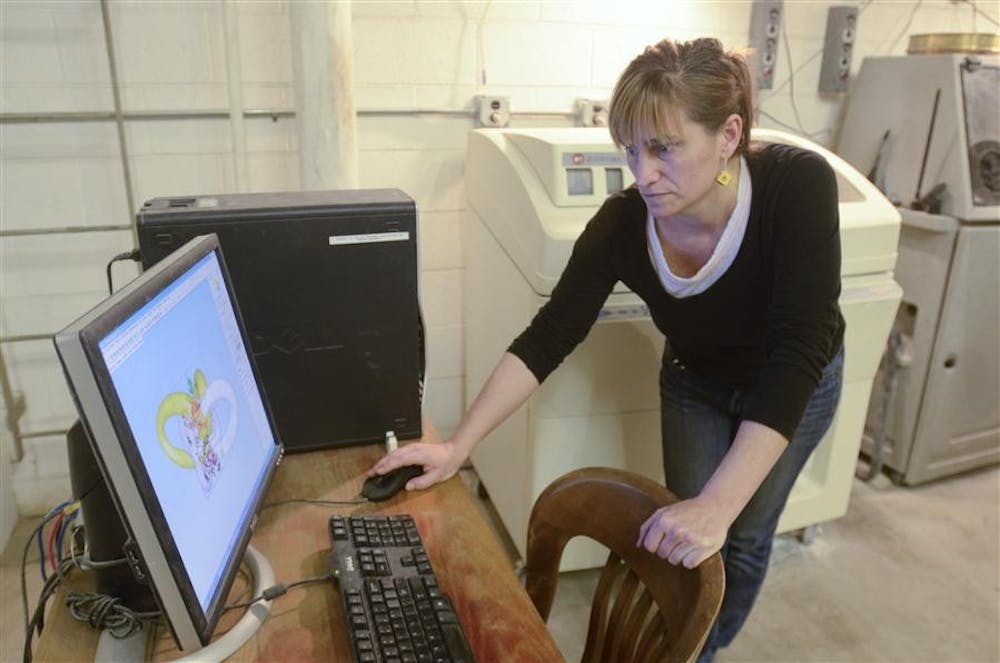Next to a metal shop in the School of Fine Arts’ McCalla building, behind a sliding glass door, sit three revolutionary machines.
Professor Nicole Jacquard said they are “the top end of this cutting-edge field.”
These machines — two monstrous printers and a CNC Wood Router — offer entry to the world of 3-D printing, where students can design an object and have it printed into tangible, life-size versions.
“We’re at this fortunate moment of time where we’re just finding out what this software and equipment can do,” said Jacquard, who has a Ph.D. that focuses on integrating the technology into the classroom. “Before, it was more industry, but now we have students pushing the limits of these machines.”
However, these machines haven’t always been in the McCalla building. They originated in an entirely different department — physics.
Professor Paul Sokol, a former director of the department’s cyclotron facility, first brought the machines to campus to build what is now known as the IU Health Proton Therapy Center, where patients can seek cancer treatment through the use of
protons.
The huge machine needed for this treatment, known as a cyclotron, was incredibly expensive, with facilities now costing about $120 million. Sokol decided he needed to carefully control costs. He purchased the 3-D printing machines in hopes of designing the components of the cyclotron by computer first, making sure all pieces fit together, before starting on the real cyclotron.
“It’s not like we were building things that sold for $19.95,” he said.
Later, when Jacquard approached Sokol about utilizing the 3-D printing machines in the fine arts department, he had no hesitation.
“We weren’t using them as heavily anymore, and the arts department was really picking up,” he said. “It seemed like the logical thing to do.”
The two wrote a grant for New Frontiers in the Arts and Humanities, a funding program. They were awarded $25,000, and the machines were then moved.
Art students have created a variety of customized objects using 3-D printing, including pieces of jewelry, freestanding sculptures and guitars.
However, 3-D printing is not confined to the SoFA.
Jacquard has already interacted with a variety of other departments interested in utilizing the software and equipment, from an individual in medical sciences hoping to scan various bird skulls to a math professor interested in making his own dice to better teach probability.
“I think we’re really moving from an era of mass production to mass customization,” Jacquard said.
Because of all the parties that could benefit, Jacquard said she is hoping to bring a fabrication lab, or “fab lab,” to IU’s campus.
This addition would reflect a partnership between IU, Ivy Tech Community College and the Bloomington community, who would ideally all be welcome to utilize the lab for both academic and personal endeavors.
Anne Fiala, a second-year graduate student in metalsmithing and jewelry design, started using a fabrication lab during her undergraduate studies at the University of Illinois at Urbana-Champaign after she severely burned her hand while glassblowing.
“One of the goals of the fab lab is to arm the general public with digital technology in order to give them the ability to make anything,” Fiala wrote in an email. “It was great to see kids as young as 5 and as old as 85 learning open source technology and finding new and improved ways to problem solve using the CUC Fab Lab resources.”
Jacquard now wants a stamp of approval from the University to start the same venture.
The biology, theater, kinesiology and computer science departments have expressed interest in the availability of a fabrication lab on campus for research purposes.
However, the ultimate goal would be a lab also based on community outreach, specifically through entrepreneurship and the reduced need to outsource production.
“It’s all about how they can use it creatively for their own practice,” Jacquard said.
Payson McNett, an associate instructor who serves as the CNC router technician, said he would enjoy the lessened workload of a fully-staffed lab.
McNett designs wooden pieces by hand, in addition to utilizing a CNC router that cuts the material for him. He stressed that traditional ways of working with material shouldn’t be entirely lost, but enhanced.
“It is very important to me to work with both contemporary and classical means of creating,” he said.
To fund the new space, Jacquard and her partners are currently applying for grants. Until the time when the fabricated lab can become a reality on campus, she maintains high hopes for the future.
“We’re thinking of a larger picture,” she said. “We want to do something that can benefit the whole Bloomington community.”
Students design sculptures, guitars in "fab lab," revolutionary 3-D printing press

Get stories like this in your inbox
Subscribe





